The intricate relationship between stress and hair loss has garnered significant attention in recent years. Chronic stress has an impact on various aspects of health, including the condition of one’s hair. This connection has led many to question: does stress cause hair loss? Research indicates that prolonged periods of mental stress and anxiety can indeed contribute to hair thinning and shedding, making stress management a crucial aspect of maintaining healthy hair.
This article aims to explore the mechanisms behind stress-related hair loss and provide practical strategies to address this issue. It will delve into the signs of stress-induced hair loss, common stressors that trigger it, and lifestyle changes to promote hair health. Additionally, the discussion will cover natural remedies, medical treatments, and prevention strategies for stress-related hair loss. By understanding these factors, individuals can take proactive steps to mitigate the effects of stress on their hair and overall well-being.
Please also review AIHCP’s Stress Management Consulting Certification.
Understanding the Link Between Stress and Hair Loss
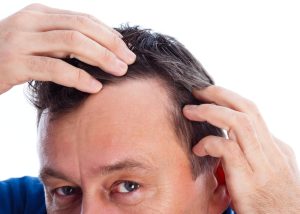
The connection between stress and hair loss has been a subject of significant scientific inquiry in recent years. Research has shown that chronic stress has an impact on various aspects of health, including the condition of one’s hair. This relationship is complex and involves multiple biological mechanisms that affect hair growth cycles and follicle health.
Types of stress-related hair loss
Stress can lead to different types of hair loss, each with its own characteristics and underlying mechanisms:
- Telogen effluvium: This is the most common form of stress-related hair loss. It occurs when a significant number of hair follicles prematurely enter the resting (telogen) phase of the hair growth cycle. Telogen effluvium can be acute, lasting less than six months, or chronic, persisting for longer periods. It typically results in diffuse thinning of hair on the scalp.
- Alopecia areata: This autoimmune disorder causes patchy hair loss and is thought to be triggered by environmental factors, including stress. It affects the immune and hormonal microenvironments of the hair follicle, leading to hair loss in well-defined areas.
- Trichotillomania: Also known as hair-pulling disorder, this condition is associated with obsessive-compulsive disorder (OCD) and can be exacerbated by stress. Individuals with trichotillomania experience an irresistible urge to pull out their own hair.
How stress affects hair growth cycles
The hair growth cycle consists of three main phases: anagen (growth), catagen (degeneration), and telogen (rest). Stress has a significant influence on this cycle:
- Prolonged resting phase: Chronic stress can cause hair follicles to remain in the telogen phase for extended periods, leading to increased hair shedding and reduced growth.
- Premature transition: Stress can force hair follicles in the anagen phase to prematurely enter the telogen phase, resulting in increased hair loss.
- Stem cell regulation: Research has shown that stress hormones, particularly corticosterone in mice (equivalent to cortisol in humans), prevent dermal papilla cells from secreting Gas6, a molecule that activates hair follicle stem cells. This inhibition can significantly impair hair regrowth.
Hormonal changes during stress
Stress triggers various hormonal changes in the body, which have direct and indirect effects on hair growth:
- Cortisol elevation: During periods of stress, the body produces higher levels of cortisol, often referred to as the “stress hormone.” Elevated cortisol levels have been shown to reduce the synthesis and accelerate the degradation of important skin elements, including hyaluronan and proteoglycans, by approximately 40%.
- Androgen activity: Stress can influence the conversion of testosterone to dihydrotestosterone (DHT), a hormone associated with androgenetic alopecia. DHT binds to androgen receptors in hair follicles, leading to the shortening of the anagen phase and prolongation of the telogen phase.
- Immune system modulation: Chronic stress can alter immune system function, potentially contributing to autoimmune conditions like alopecia areata. Some individuals with this condition may experience a reduced expression of glucocorticoids due to a weak response to acute physiological stressors.
Understanding these mechanisms provides valuable insights into the complex relationship between stress and hair loss. It also highlights the importance of stress management in maintaining healthy hair growth and preventing stress-related hair loss conditions.
Recognizing Signs of Stress-Induced Hair Loss
Stress-induced hair loss has distinct characteristics that differentiate it from other types of hair thinning. Individuals experiencing this condition may observe several key signs that indicate their hair loss is related to stress. Understanding these signs can help in identifying the problem and seeking appropriate solutions.
Excessive shedding
One of the primary indicators of stress-related hair loss is an increase in hair shedding. While it is normal to lose between 50 to 100 hairs per day, individuals experiencing stress-induced hair loss may notice a significant increase in this number. In cases of telogen effluvium, a common form of stress-related hair loss, a person may shed up to 300 strands of hair daily.
This excessive shedding often becomes apparent in various situations:
- Increased hair accumulation in hairbrushes or combs
- More hair visible in the shower drain after washing
- Hair strands frequently found on pillows or clothing
- Noticeable hair loss when touching or running fingers through the hair
It is important to note that this increased shedding typically occurs gradually over a period of 3-6 months following a stressful event. This delay is due to the hair growth cycle, where stress pushes more hair follicles into the resting (telogen) phase before shedding.
Thinning hair
As stress-induced hair loss progresses, individuals may observe a general thinning of their hair, particularly on the top of the scalp. This thinning is often more noticeable than in other areas, such as the back or sides of the head. The American Academy of Dermatology (AAD) recognizes this pattern as a common manifestation of telogen effluvium.
Key characteristics of stress-related hair thinning include:
- Overall reduction in hair volume
- Scalp becoming more visible through the hair
- Thinning that appears evenly distributed rather than in specific patterns
- Hair that feels drier and falls out more easily
It is worth noting that while the hair may appear thinner, the scalp itself typically remains healthy-looking without scales or rashes.
Bald patches
In some cases, stress-induced hair loss can manifest as distinct bald patches. This is often associated with a condition called alopecia areata, an autoimmune disorder that can be triggered or exacerbated by stress. Unlike the diffuse thinning seen in telogen effluvium, alopecia areata presents as well-defined areas of hair loss.
Characteristics of bald patches in stress-related hair loss include:
- Small, round patches of baldness on the scalp or other parts of the body
- Patches that may expand or join together over time
- Possibility of total loss of scalp or body hair in severe cases
- Hair follicles remain intact, allowing for potential regrowth
It is important to recognize that the onset of these symptoms typically follows a major stressful life event. Such events may include trauma, the death of a loved one, illness, surgery, emotional turmoil, or rapid weight loss. The hair loss usually becomes noticeable a few months after the stressful event occurs, reflecting the delay in the hair growth cycle’s response to stress.
Common Stressors That Can Trigger Hair Loss
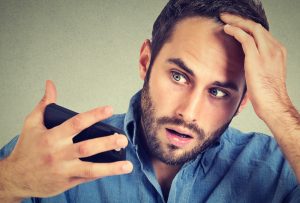
Stress-induced hair loss has been linked to various life events and circumstances that place significant pressure on individuals. Understanding these common stressors can help in identifying potential triggers and managing their impact on hair health. Stress management can help identify stressors.
Work-related stress
The workplace has emerged as a significant source of stress that can contribute to hair loss. Research has shown that individuals with little control over their workload face an increased risk of health issues, including hair thinning. A study conducted in 2014 by UK hair care brand Percy & Reed revealed that 50% of men and 75% of women attributed their thinning hair to work-related stress. Interestingly, the study also found that one in five individuals earning over £75,000 per year considered their stressful job as the cause of their hair loss, compared to one in ten for those earning £15,000 or less annually.
Financial stress
Financial difficulties have been identified as a major stressor that can have an impact on hair health. The Consumer Credit Counseling Service (CCCS) in the UK conducted a survey that highlighted the health consequences of mounting debts during economic downturns. The study found that 46% of respondents believed their financial problems had affected their health, with symptoms including hair loss among other issues. Financial stress can manifest in various forms, such as:
- Business-related financial problems
- Mounting debts
- Job loss or income reduction
- Economic downturns
Relationship issues
Emotional stress stemming from relationship problems has been recognized as a significant trigger for hair loss. Some common relationship stressors include:
- Divorce or separation
- Loss of a loved one
- Heartbreak
- Parenting challenges
Heartbreak, in particular, has been identified as one of the most common causes of hair loss due to emotional stress or trauma. The duration of hair loss in these cases can persist for as long as the emotional distress continues, with an additional 7 to 8 months required for proper hair regrowth.
Health concerns
Various health-related issues and events can act as stressors that trigger hair loss. These may include:
- Major surgeries or medical procedures
- Recovery from illness
- High fever
- Excessive weight loss
- Childbirth
- Stopping birth control pills
In some cases, health-related stress can lead to specific types of hair loss, such as alopecia areata. This condition is characterized by sudden bald patches on the scalp and can be triggered by extreme stress or traumatic events. Additionally, individuals with post-traumatic stress disorder (PTSD) may experience prolonged hair loss due to persistently elevated stress hormone levels, which can prevent hair regrowth after shedding.
It is important to note that while stress is a significant factor in hair loss, genetic predisposition can also play a role in conditions like alopecia areata. Furthermore, the impact of stress on hair loss can vary depending on the severity and duration of the stressful situation. In some cases, acute stress may lead to temporary hair shedding, while chronic stress can result in more persistent hair loss issues.
Lifestyle Changes to Reduce Stress and Promote Hair Health
Stress Management Techniques
Stress has a significant impact on hair health, potentially leading to conditions such as telogen effluvium. To combat this, individuals can adopt various stress management techniques. Mindfulness and meditation have emerged as powerful tools to manage stress and promote relaxation. These practices, when incorporated into daily routines, can improve overall well-being and support healthy hair growth.
One effective technique is square breathing, which involves slow, deep breaths to calm the mind and body. To practice this, one should inhale deeply through the nose, hold the breath for a few seconds, and exhale slowly through the mouth. Repeating this process several times while focusing on the sensation of each breath can help reduce stress levels.
Another beneficial practice is the body scan technique. This mindfulness and relaxation method involves mentally scanning the body from head to toe, paying attention to physical sensations and areas of tension. Regular practice of body scans can help individuals become more attuned to their body’s needs and better manage physical and mental tension.
Guided visualization is another effective mindfulness and meditation technique. It involves using mental imagery to create a state of deep relaxation, focus, and clarity. In a guided visualization session, a facilitator or recorded script guides individuals through a series of mental images and sensory experiences, helping them enter a calm and reflective state.
Healthy Diet for Hair Growth
A balanced diet plays a crucial role in maintaining hair health and promoting growth. Consuming foods rich in essential nutrients can support hair follicles and minimize stress-induced hair loss. Some key nutrients and foods to include in a hair-healthy diet are:
- Iron and Vitamin C: Spinach is an excellent source of iron, and when combined with vitamin C-rich foods, it enhances iron absorption. A spinach salad with mushrooms or hard-boiled eggs, both rich in vitamin D, can help reduce hair loss.
- Copper and Zinc: These minerals are essential for proper body function and healthy hair growth. Foods rich in zinc include oysters, black sesame seeds, spinach, eggs, walnuts, green peas, chickpeas, sunflower seeds, oatmeal, and wheat germ.
- Protein: As hair is primarily composed of protein, it is crucial to include adequate protein in the diet. Salmon, a marine-based protein loaded with vitamins and omega-3 fatty acids, has been shown to be particularly effective at boosting hair growth.
- Beta Carotene: Found in orange-colored vegetables and fruits such as pumpkin, carrots, mangoes, sweet potatoes, and sweet melons, beta carotene protects hair from becoming dull and dry. It also stimulates the production of sebum, an oily fluid essential for healthy hair.
Exercise and Its Benefits
Regular physical activity plays a significant role in maintaining overall well-being, including hair health. Exercise enhances blood circulation, ensuring that vital nutrients and oxygen reach the hair follicles. This improved blood flow supports the nourishment of hair follicles, fostering hair growth and minimizing hair loss.
Cardio exercises, such as running, biking, or swimming, can help improve blood circulation throughout the body, including the scalp. These workouts elevate heart rate and promote blood flow, supplying more oxygen and essential nutrients to the roots of the hair. Incorporating 30 minutes of cardio sessions into daily routines can yield optimal results.
Strength training exercises, like lifting weights or using resistance bands, can also have positive effects on overall hair health. These exercises aid in muscle development and indirectly contribute to promoting healthy hair growth. Additionally, participating in strength training can help lower stress levels, which in turn benefits hair health.
High-Intensity Interval Training (HIIT) is another effective form of exercise for hair health. HIIT involves engaging in bursts of physical activity followed by periods of rest or less strenuous exercise. These workouts are beneficial for increasing blood circulation and triggering the production of growth hormones, which can contribute to promoting hair growth. HIIT sessions can be completed in 10-15 minutes and incorporated into weekly routines multiple times.
Natural Remedies for Stress-Related Hair Loss
Herbal supplements
Herbal remedies have long been utilized in various beauty and hair care routines, with some evidence suggesting their potential to promote hair growth through different mechanisms. Several herbs have shown promise in addressing stress-related hair loss:
- Horsetail (Equisetum arvense): Rich in silica, horsetail penetrates hair follicles and the hair matrix, potentially thickening hair and reducing hair loss.
- Red clover (Trifolium pratense): Studies indicate that red clover may block the enzyme 5-alpha reductase, which converts testosterone into dihydrotestosterone, a hormone associated with hair loss. Additionally, it has been shown to help lower inflammation, potentially aiding hair growth.
- Stinging nettle (Urtica dioica): Research suggests that stinging nettle extract may increase dermal papilla cell growth, which plays a crucial role in regulating hair growth. It is also rich in beta-sitosterol, a plant chemical that may stimulate hair growth factors.
Essential oils
Essential oils have gained popularity for their potential benefits in improving hair health, with some oils showing promise in promoting hair growth and addressing stress-related hair issues:
- Rosemary oil: Known for its anti-inflammatory properties, rosemary oil may promote hair growth, prevent premature graying, and combat dandruff. It has been shown to improve circulation and encourage nerve growth when applied to the scalp.
- Peppermint oil: The menthol in peppermint oil acts as a vasodilator, potentially improving blood flow and circulation in the scalp, which may encourage faster and stronger hair growth.
- Lavender oil: Studies have demonstrated lavender oil’s ability to promote faster cell growth and repair. It may also help reduce stress levels, potentially minimizing hair loss during high-stress periods.
- Cedarwood oil: With antibacterial and antifungal properties, cedarwood oil may help treat scalp conditions contributing to dandruff or hair loss. It has been found to help balance oil-producing glands in the scalp.
- Thyme oil: This oil has been shown to stimulate the scalp and potentially prevent hair loss. However, due to its potency, it should be used sparingly and diluted with a carrier oil.
- Tea tree oil: Known for its cleansing, antifungal, and antimicrobial properties, tea tree oil may help unclog hair follicles and promote faster hair growth when applied topically.
Scalp massage
Scalp massage has emerged as a promising natural remedy for stress-related hair loss. Research suggests that this technique may help promote hair growth and improve overall scalp health:
- Increased blood flow: Scalp massage enhances blood circulation to the hair follicles, potentially encouraging hair growth and improving the delivery of nutrients to the scalp.
- Stress reduction: The relaxing effect of scalp massage may help lower stress levels, which can be beneficial in combating stress-induced hair loss.
- Mechanical stimulation: Studies using finite element method analysis have demonstrated that scalp massage results in horizontal movement of the skin surface and displacement of subcutaneous tissue, potentially inducing mechanical stress on hair follicle cells.
- Gene expression changes: Research has shown that scalp massage may lead to changes in gene expression in human dermal papilla cells, which play a crucial role in hair growth.
- Increased hair thickness: A study conducted on healthy Japanese men found that standardized scalp massage resulted in increased hair thickness.
To perform a scalp massage, individuals can use their fingertips to apply light to medium pressure to the scalp, moving in small circles. Alternatively, a scalp massaging tool can be used. For enhanced benefits, essential oils such as lavender or peppermint can be incorporated into the massage routine, as animal studies have shown their potential to promote hair growth.
Medical Treatments for Stress-Induced Hair Loss
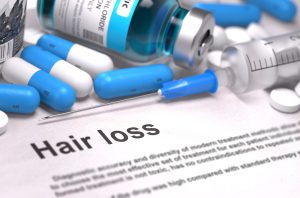
Topical Medications
Topical minoxidil has emerged as a primary treatment for stress-induced hair loss. This FDA-approved medication has shown efficacy in treating various types of hair loss, including androgenetic alopecia, alopecia areata, and telogen effluvium. Available as a foam or liquid, minoxidil is applied directly to the scalp twice daily. It works by shortening the telogen phase and prolonging the anagen phase of the hair growth cycle, leading to increased hair diameter and length.
Minoxidil’s mechanism of action involves several pathways. It acts as a vasodilator, enhancing blood flow to hair follicles. Additionally, it induces the Wnt/β-catenin signaling pathway and has anti-androgenic and anti-inflammatory properties. The medication also increases vascular endothelial growth factor (VEGF) expression, which plays a crucial role in maintaining the anagen phase of hair growth.
It’s important to note that visible results may take four months to a year, and initial increased shedding is common. Side effects are generally mild and may include scalp redness and irritation.
Oral Medications
For cases where topical treatments prove insufficient, oral medications offer alternative solutions. Finasteride, primarily prescribed for male pattern baldness, inhibits the production of dihydrotestosterone (DHT), a hormone associated with hair follicle destruction. Taken once daily, finasteride typically shows results after four months, with significant hair growth potentially visible after a year.
Low-dose oral minoxidil has recently gained attention as a treatment for various hair disorders. Studies have shown that doses ranging from 0.25 to 5 mg daily can be effective for both male and female pattern hair loss, with lower doses (0.25-1.25 mg) showing promise in treating female pattern hair loss, traction alopecia, and telogen effluvium. Higher doses (2.5-5 mg) have demonstrated effectiveness in treating male pattern hair loss.
For women experiencing female pattern baldness, antiandrogen medications such as spironolactone and oral contraceptives containing estrogen may be prescribed. These medications work by inhibiting androgens that can damage hair follicles.
In cases of autoimmune-related hair loss, corticosteroids may be prescribed to suppress the immune system’s attack on hair follicles. These can be administered topically, through injections, or orally, depending on the severity and type of hair loss.
Hair Restoration Procedures
When medication alone is insufficient, hair restoration procedures offer more advanced solutions. Platelet-Rich Plasma (PRP) treatment utilizes the body’s natural healing compounds to stimulate new hair growth. This procedure involves extracting platelet-rich plasma from the patient’s blood and injecting it into various sites on the scalp.
Another innovative approach is Adipose Stem Cell Treatment, which involves injecting stem cells extracted from body fat deposits into the scalp. These stem cells have remarkable regenerative properties that can help spur new hair growth.
PDO Threading is a newer treatment that uses dissolving polydioxanone (PDO) surgical threads implanted just below the skin on the scalp. This technique triggers a natural healing response that can rejuvenate dormant hair follicles.
For more severe cases, surgical options such as hair grafting and scalp reduction may be considered. Grafting involves transplanting hair from one part of the body to bald areas of the scalp, while scalp reduction removes non-hair-bearing skin to stretch remaining hair-bearing skin over bald areas.
These medical treatments and procedures offer a range of options for individuals experiencing stress-induced hair loss. The choice of treatment depends on various factors, including the type and severity of hair loss, overall health, and individual preferences. It’s crucial to consult with a healthcare provider to determine the most appropriate treatment plan.
Prevention Strategies for Stress-Related Hair Loss
Regular self-care routines
Implementing regular self-care routines has a significant impact on preventing stress-related hair loss. One crucial aspect of self-care is maintaining a healthy diet. Experts recommend consuming adequate protein, especially for vegetarians and vegans, with a daily intake of 40 to 60 grams. The Mediterranean diet, rich in fruits, vegetables, and lean proteins, has shown promise in minimizing hair loss.
Ensuring proper nutrition through vitamins and minerals is essential for hair health. Vitamins A, B, C, D, E, as well as zinc, biotin, and iron, contribute to maintaining healthy hair, skin, and muscle tissue. However, it is advisable to consult a healthcare provider before adding new supplements to one’s diet. A blood test can determine if there are any nutritional deficiencies that may be contributing to hair loss.
Regular exercise has emerged as an effective strategy for managing stress and promoting overall well-being. Incorporating physical activity into one’s routine can help reduce stress levels and improve blood circulation, which is beneficial for hair health. Additionally, getting enough sleep is crucial, with most adults requiring between seven and nine hours per night. Adequate sleep has been shown to decrease stress levels and support overall health.
Maintaining a healthy work-life balance
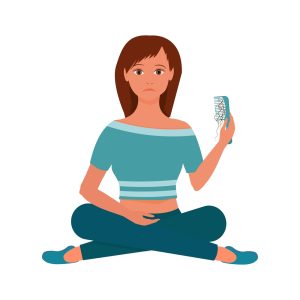
Achieving a healthy work-life balance is paramount in preventing stress-related hair loss. This balance involves distributing time effectively between personal and professional obligations. For individuals running their own businesses, such as salon owners, setting strict work-life boundaries is crucial to avoid burnout.
To maintain this balance, experts suggest several strategies:
- Drawing a clear line between work and home life
- Establishing regular meal times and prioritizing healthy eating habits
- Practicing “switching off” from technology and work-related communications
- Outsourcing tasks when possible to reduce workload
- Taking regular breaks, including long weekends or short vacations
- Learning to say “no” to excessive demands on time and energy
It is important to recognize that work-life balance may look different for everyone. The key is to ensure that not all non-sleeping hours are dedicated to work or work-related thoughts. Making time for enjoyable activities, hobbies, and social interactions is essential for maintaining overall well-being and reducing stress levels.
Seeking professional help when needed
When stress-related hair loss becomes a concern, seeking professional help is a crucial step in prevention and management. Experts recommend making an appointment with a board-certified dermatologist as soon as hair loss is noticed. Dermatologists can provide tailored advice and treatment options based on individual needs and the specific cause of hair loss.
For individuals experiencing high levels of stress that impact their mental health, consulting a therapist can be beneficial. Many employers offer employee assistance programs that can connect individuals with mental health professionals experienced in stress management. Counselors trained in Stress Management can help clients find better ways to manage stress.
In some cases, stress-related hair loss may be associated with conditions such as alopecia areata, telogen effluvium, or trichotillomania. These conditions often require professional diagnosis and treatment. A healthcare provider can assess the situation and recommend appropriate interventions, which may include medication, therapy, or lifestyle changes.
It is important to remember that seeking help is not a sign of weakness but a proactive step towards managing stress and preventing further hair loss. Early intervention can lead to better outcomes and help individuals regain control over their hair health and overall well-being.
Conclusion
The connection between stress and hair loss has a significant impact on many individuals’ lives, affecting both their physical appearance and emotional well-being. This article has explored various aspects of stress-induced hair loss, from its biological mechanisms to practical strategies to manage and prevent it. By understanding the signs of stress-related hair loss, recognizing common triggers, and implementing lifestyle changes, individuals can take proactive steps to maintain healthy hair and reduce the effects of stress on their overall health.
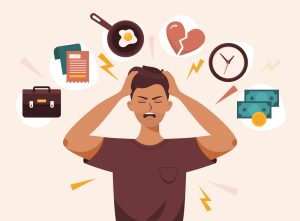
Ultimately, addressing stress-related hair loss requires a holistic approach that combines self-care, medical interventions when necessary, and a commitment to maintaining a balanced lifestyle. By incorporating stress management techniques, adopting a nutrient-rich diet, staying physically active, and seeking professional help when needed, individuals can minimize the impact of stress on their hair health. Remember, hair loss due to stress is often reversible, and with the right approach, it’s possible to regain not just hair growth, but also a sense of confidence and well-being.
Please also review AIHCP’s Stress Management Consulting Certification and see if it matches your academic and professional goals. The program is online and independent study and open to qualified professionals seeking a four year certification.
FAQs
How can I prevent my hair from falling out due to stress?
To treat hair loss related to stress, ensure you get adequate sleep (aim for 7-8 hours nightly), hydrate well, and maintain a balanced diet. Limit your intake of sugar and caffeine. Engage in regular physical activities and consider stress-reduction practices such as yoga, meditation, or mindfulness. It’s also beneficial to discuss your concerns with someone.
Is it possible for hair to regrow after loss due to stress?
Yes, hair can regrow following stress-related loss. This type of hair loss, known as telogen effluvium, typically results in hair thinning, especially on the top of the head. While there are treatments available to help reverse this condition, hair usually begins to regrow naturally within three to six months.
What supplements are beneficial for hair loss due to stress?
Supplements like biotin, iron, and omega-3 fatty acids may help to reverse hair loss caused by stress. These supplements support healthy hair growth and can improve hair density. However, it’s important to consult with a healthcare provider before beginning any new supplement regimen.
How can I cope mentally with hair loss?
If hair loss is causing you to feel depressed or anxious, consider engaging in talk therapy. Losing hair can significantly affect your self-esteem and self-perception. Talking with a therapist or mental health professional can help you manage negative emotions, provide context to your hair loss, and help you plan your next steps.
Additional Resources
Flavin, D. (2023). “Can stress cause hair loss?”. Mayo Clinic. Access here
Bryant, E. (2021). “How stress causes hair loss”. National Institute of Health. Access here
Jay, K. (2019). “Does Stress Cause Hair Loss?”. Healthline. Access here
“Telogen Effluvium”. Cleveland Clinic. Access here
“Hair Loss” (2024). Mayo Clinic. Access here
